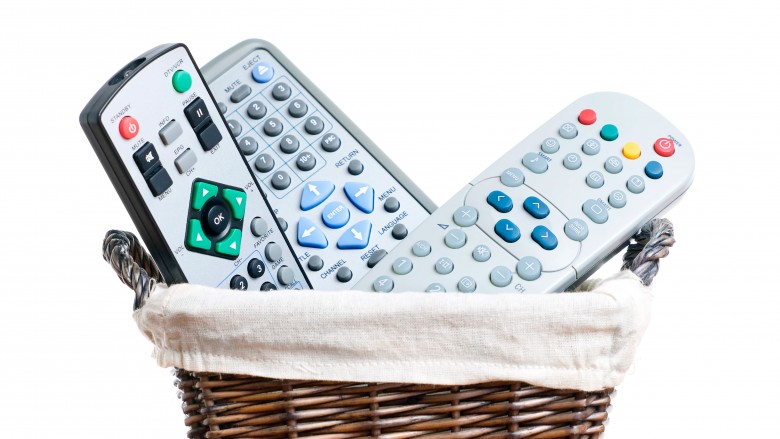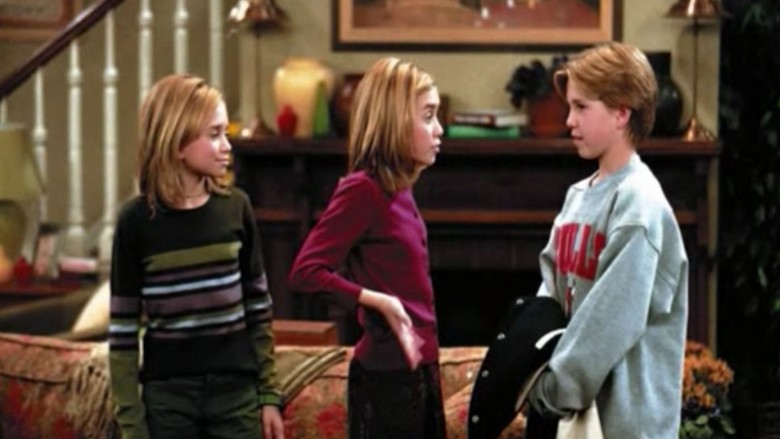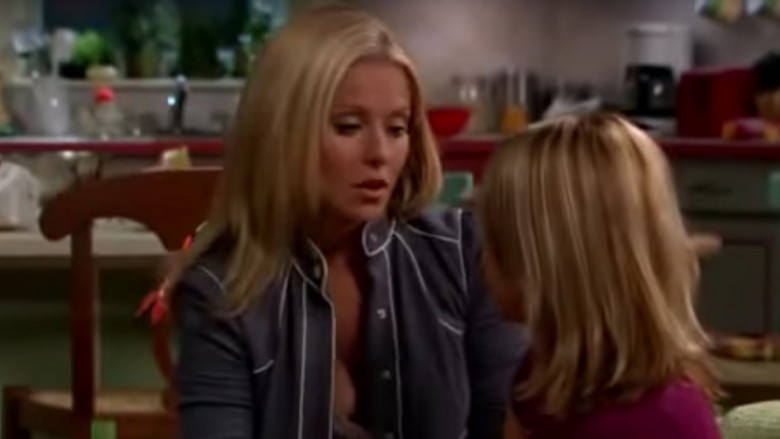The Real Reason Why TGIF Disappeared
The 1990s were the first, and probably only, time in recorded history that the coolest place to be on Friday nights was in front of the TV, watching network sitcoms. ABC's two-hour "TGIF" lineup presented clean, goofy, and beloved sitcoms fit for the whole family, including Family Matters, Full House, Mr. Belvedere, Boy Meets World, Dinosaurs, and more. (They almost always involved hugging, and the audience going, "awwwwww."). TGIF dominated the ratings for nearly a decade, because Urkel is a better way to kickoff the weekend than, say, Diagnosis Murder.
But then, abruptly ... TGIF was gone. You wanna know what killed TGIF (which actually stood for "thank goodness, it's funny")? As Michelle Tanner would say, "you got it, dude!"
The rise of the multiple TV household
If TGIF brought in big ratings, wouldn't more TV sets mean more viewers? Not really, because by the late '90s, televisions had grown so inexpensive (or the economy was so good, Americans had could blow their disposable income on extra TVs), the majority of households had at least two sets by then.
This meant that the whole family didn't have to watch one show all at the same time anymore. Parents could watch one thing on the TV in their bedroom, while the kids could watch something else on the living room TV. Mom and Dad could finally watch something with sexual situations on HBO in peace, without the kids barging in. Meanwhile, the kids could watch TGIF on their own TV ... but without parents lurking, they certainly didn't have to.
ABC wanted cooler shows
In the late '90s, ABC's bigwigs did what a lot of viewers had already done with TGIF: they grew out of it. Michael Jacobs, executive producer of TGIF shows Boy Meets World and Dinosaurs, told the Los Angeles Times that he kept attending programming development meetings at ABC after the Disney takeover, where he said that "edge" was their "favorite word." Yep, despite the network being bought in 1995 by Disney — a company so obsessed with cleanliness and being conservative, it once banned its park employees from having mustaches — ABC actually wanted fewer shows that appealed to 11-year-olds, and more that appealed to cool young adults. You know, those cool, hip, twentysomethings that stay home on Friday nights and watch network TV.
This vision may have had something to do with the hiring of new ABC president of entertainment Jamie Tarses, who jumped to the alphabet network from NBC after developing cool young adult comedies there, like the mega-hit Friends. In other words, ABC wanted the next Friends, and Step by Step just wasn't it.
Other networks pulled away viewers with their own versions of TGIF
After ABC canceled TGIF mainstays Family Matters and Step by Step in 1997, CBS picked them up and used them to anchor its own two-hour chunk of gentle family sitcoms. CBS called their blatant ripoff ... TGIF. Kidding — they called it Friday Night Block Party, which wasn't nearly as catchy.
Besides Family Matters and Step by Step, the other two shows in the FNBP were Meego, which starred Bronson Pinchot as a wacky alien who is confused and amused by our wacky Earth ways, and The Gregory Hines Show, a family comedy starring America's favorite dancer but featured none of Hines's amazing dancing. As for the other two: while Family Matters and Step by Step were old and tired by then, they still pulled in viewers who wanted their regular, old Friday night shows the way they'd had them for years.
While all the Block Party shows were canceled after one season, due to low ratings, it did manage to cut into ABC's ratings for what still remained on TGIF, which were now teen-oriented shows like Boy Meets World, Clueless and Sabrina, the Teenage Witch. The competition ultimately worked to hurt both sides — Clueless fled for UPN in 1997, where it ran far longer than it ever had on ABC, and in 2000, Boy Meets World was canceled, Sabrina moved to the WB, and the TGIF brand was dismantled entirely.
Newer entries in the lineup didn't connect with viewers
The shows most commonly associated with TGIF are the early ones. As those shows started to age (or rather, the cute kids that starred on them got old and less-cute) and plunge in popularity, ABC filled in the Friday nights gaps with a bunch of new shows that just didn't inspire as many future nostalgia-filled Internet articles as their predecessors.
Seriously, only a true TV buff will remember late-stage TGIF misses like You Wish (about a cool genie), Teen Angel (about a cool teen who was also a cool angel) Brother's Keeper (starring cool teen dream Joey Lawrence and his smaller, less cool clone-brothers), and Hiller and Diller, (about two uncool middle-aged TV sitcom writers). Not even a brand new Muppets series called Muppets Tonight could save the night. If only they had greenlit more genies.
The failure of an Olsen Twins comeback show
Disney and ABC gave the dying TGIF one last big push in 1998, with the most TGIF sitcom imaginable: a family sitcom called Two of a Kind, starring Mary Kate and Ashley Olsen. These were the twins who'd played baby Michelle on Full House, except now they were tweens and could talk, and both now appeared on-screen at the same time.
Two of a Kind was developed and produced by Miller-Boyett Productions, the house that had made six shows for TGIF over the years, including Full House, Family Matters, and Step by Step. But Two of a Kind pulled in small ratings, and it went away after a single season. Maybe it was because viewers were flummoxed by the sight of two Olsens at the same time, or that the sweet and cute baby from Full House was now concerned with teen issues instead of saying "you got it, dude!" whenever possible. For whatever reason, Two of a Kind failed to catch on — if the people who literally made TGIF couldn't breathe new life into it, then that proved to everyone involved that TGIF was just about over.
A TGIF reboot didn't work out
In 2003, ABC apparently gave up on creating cool sitcoms for cool grown-ups, and just relaunched the very familiar "TGIF" programming block on Friday nights. The shows were family-friendly, but a tad more sophisticated and older-skewing than they'd been 10 years prior ... almost as if it were an attempt to lasso in the exact same viewers that were now 10 years older.
Problem with that shrewd move: those adults either had stuff to do on Fridays now or were watching other stuff on Fridays, because the new TGIF wasn't at all the cultural phenomenon its predecessor was. The lineup included pre-existing shows George Lopez and Life with Bonnie, along with new shows Married to the Kellys and Hope & Faith, the latter starring bubbly talk show host Kelly Ripa, who apparently needed a third job to go with her Live with Regis and Kelly and All My Children gigs.
The lineup did so-so in the ratings, but frequently lost out to CBS dramas like JAG. (You just can't beat JAG!) But "TGIF 2.0" returned in fall 2004, with almost an entirely new lineup. Lopez moved to another night, Bonnie and Kellys were canceled, and joining Hope & Faith were 8 Simple Rules, Less Than Perfect, and Complete Savages. But this new lineup still failed to do what the original had done so well: link the shows in some way, via crossovers or cute hosting segments. Instead, they were just a bunch of random sitcoms clumped together. How are you supposed to watch a whole block of comedies if characters from those sitcoms don't appear on each other's shows?
By the time the 2005-06 season began, only Hope & Faith and Less Than Perfect survived, but they were moved to other nights, and ABC finally stopped branding Friday nights as TGIF. The only vestige of the '90s that still remains on ABC today: the long-running bummer of a newsmagazine called 20/20, our childhood's signal that Friday night fun was done.



